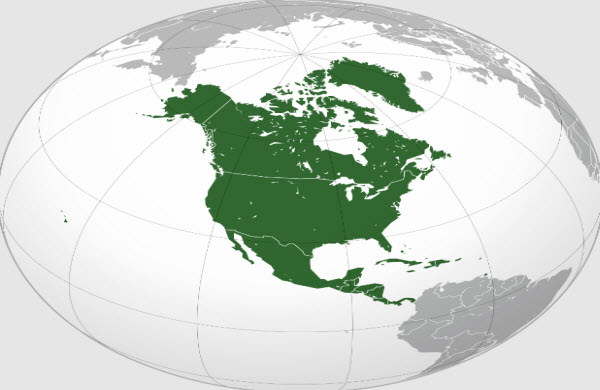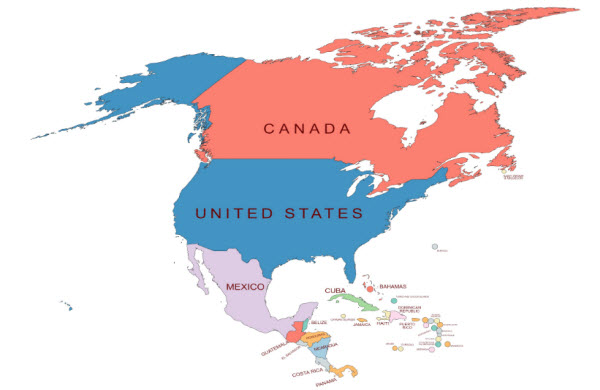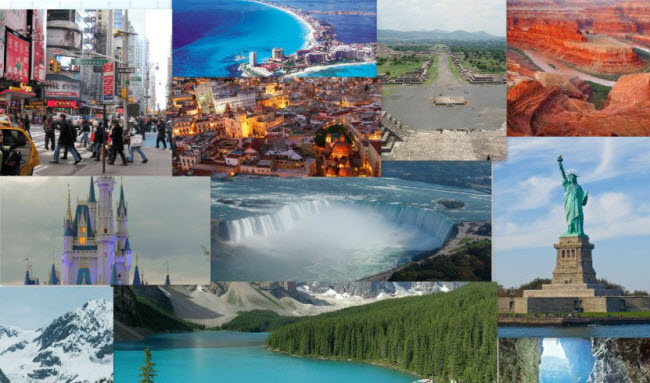North America, the third-largest continent by area after Asia and Africa, covers approximately 4.8% of the Earth’s surface and 16.5% of the land area. It is bordered by the Arctic Ocean to the north, the Atlantic Ocean to the east, South America and the Caribbean to the southeast, and the Pacific Ocean to the west and south. Greenland, situated on the North American tectonic plate, is geographically included in this continent despite its political affiliation with Europe.

North America is the fourth most populous continent and has been a focal point for migration over the centuries. Its diverse cultures reflect the variety of ethnic groups present, including European colonizers, indigenous peoples, and African slaves. Languages spoken across the continent primarily derive from European languages, with English, Spanish, and French being predominant. Despite this, regions in Canada, the United States, Mexico, and Central America continue to be home to indigenous peoples who uphold their cultural traditions and speak their native languages.
The continent was named after the Italian explorer Amerigo Vespucci, who, between 1497 and 1502, explored South America and was the first European to suggest that the Americas were not part of Asia but a distinct landmass unknown to Europeans. Some theories suggest that the name might be derived from the Amerisk mountains in Central America or from the Maya language, where “America” translates to “land of the always strong wind” or “land of the spirit of life.”
North America spans approximately 24.71 million square kilometers. Canada is the largest country by area, followed by the United States, Mexico, and Nicaragua. The smallest countries are Saint Kitts and Nevis, Grenada, Saint Vincent, and Barbados.

Geographical Regions of North America
North America can be divided into four major geographical regions:
- The Great Plains: Extending from the Gulf of Mexico to the Canadian Arctic, this region is characterized by its flat and expansive landscape.
- The Rocky Mountain Region: This includes the geologically young Rocky Mountains, the Great Basin, California, and Alaska.
- The Canadian Shield: A vast, relatively flat, and elevated region in northeastern Canada.
- The Eastern Region: This encompasses the Appalachian Mountains, the Atlantic coastal plain, Florida, and the Mexican plateaus.
Due to its vast area stretching from the Arctic Circle to the Tropic of Cancer, North America experiences a wide range of climates. In northern Canada, tundra fields have temperatures ranging from 10 to 20 degrees Celsius. The western climate, west of the Cascade Mountains, is temperate, while California experiences a Mediterranean climate. The eastern part of North America has a humid continental climate, extending from the eastern coast to northern Kansas. The southeastern part of Texas has a humid subtropical climate, which includes some of the most humid cities in the U.S. Tropical climates are found in Caribbean islands and parts of Central America, with rainfall and high temperatures year-round.

History of North America
Anthropologists believe that the indigenous peoples of North America arrived around 40,000 years ago by crossing the Bering Strait. Some experts suggest that early settlers also migrated down the Pacific coast to South America. Scientific evidence links Native Americans to Asian peoples, particularly from Eastern Siberia, based on linguistic and genetic connections.
After the last Ice Age, about 12,500 years ago, a wide range of prehistoric cultures developed across the continent. The development of stone tools was crucial in this expansion. Long before European arrival, small groups of hunter-gatherers existed across the Americas, living off wild plants and animals. These groups were eventually replaced by larger, more complex societies that practiced agriculture and animal husbandry.
During the Christianization period, the Arawak people migrated from Venezuela to the Lesser Antilles, eventually reaching the Greater Antilles and establishing large settlements in Cuba, Puerto Rico, and Jamaica. In the southern part of the continent, the Maya civilization made significant cultural advancements, developing a written language and contributing to art, architecture, astronomy, and mathematics between 250 and 900 AD.
North American cultures continued to evolve before European contact. Inuit and Aleut people lived in dome-shaped homes in the Arctic, while other groups inhabited the southern polar regions of Alaska and western Canada. Expansion continued, with new agricultural techniques being developed for crops like corn, which is now a staple food worldwide.
During the Viking Age, from the late 8th to the mid-11th century, Norse explorers traveled to places such as Iceland, Greenland, and Newfoundland. Leif Erikson is believed to have reached Newfoundland around 1000 AD. By the 13th century, the Aztec Empire dominated much of Central America, from Mexico to Belize, Guatemala, El Salvador, Honduras, Nicaragua, and northern Costa Rica.
In 1492, Christopher Columbus, financed by Queen Isabella I and King Ferdinand II, embarked on a voyage to the New World, landing in the Bahamas. This marked the beginning of significant European exploration and colonization of North America. By 1497, John Cabot discovered the eastern coast of what would become Canada. Giovanni da Verrazzano explored the eastern coast of North America from Florida to eastern Canada in 1524, followed by Jacques Cartier’s voyages for the French crown in 1534, reaching the St. Lawrence River.
In 1500, Spain began colonizing parts of the New World, founding Nueva Cadiz in Venezuela and Santa Maria la Antigua del Darien in present-day Colombia and Panama. These were the first European settlements in the Americas. Spanish explorations included internal campaigns leading to the conquest of Mexico and the Yucatán Peninsula. Vasco Núñez de Balboa crossed the Isthmus of Panama in 1513, becoming the first European to see the Pacific Ocean. Hernán Cortés conquered Mexico on April 22, 1519, initiating 300 years of Spanish dominance in Mexico, Central America, and the Caribbean.
European exploration led to a significant decline in the indigenous population due to diseases and violent conflicts. The British, French, and Spanish established vast territories, while smaller powers like the Netherlands and Sweden claimed smaller regions. French settlements included Port Royal (1604) and Quebec City (1608), while the first successful English settlement was Jamestown (1607) in Virginia, followed by Plymouth Colony (1620) in Massachusetts.
By the late 17th century, colonization in North America accelerated, leading to conflicts and wars. The mid-18th century saw rising independence movements across the continent. The American Revolution led to the independence of the thirteen original British colonies in 1776, forming the United States. Canada emerged from the unification of British and French-controlled northern territories.

In 1810, New Spain, which extended from southwestern modern-day United States through Central America, declared independence as the Mexican Empire. Guatemala, a part of this empire, was the first Central American country to become independent. The U.S. declared war on Britain in 1812 over territorial disputes, resulting in no major territorial changes but resolving lingering issues from the American Revolutionary War.
Two of the most destructive events in North American history were the American Civil War (1861-1865), which ended slavery in the U.S. but caused widespread destruction in the South, and numerous conflicts between the U.S. government and Native Americans. After the Civil War, the U.S. expanded its influence into Latin America and other regions, purchasing Alaska from Russia in 1867 and acquiring several Spanish colonies, including Cuba and Puerto Rico, during the Spanish-American War of 1898.
The Panama Canal, opened in 1914, facilitated ship travel between the Atlantic and Pacific Oceans, avoiding the lengthy route around Cape Horn. The early 20th century brought prosperity to the U.S. and, to a lesser extent, Canada, though the Great Depression caused significant economic hardship. The U.S. emerged as a superpower following World War II.
From 1936 to 1949, Mexico experienced a popular uprising against an anti-Catholic government, and several Caribbean islands saw the beginnings of decolonization. The Cuban Revolution introduced the Soviet Union to Latin America, leading to the Cuban Missile Crisis during the Cold War. By 1962, Guatemala and Trinidad and Tobago had gained political independence, marking the start of a formal decolonization period in the Caribbean, with countries in the continent beginning to integrate and live in peace.
Demographics

North America has a population of approximately 579 million, representing 7.5% of the global population of 7.1 billion, making it the fourth most populous continent after Asia, Africa, and Europe. The United States is the most populous country (335.8 million), followed by Mexico (132.3 million), Canada (38.6 million), and Guatemala (18.7 million). The least populous countries are Saint Kitts and Nevis (54,100), Dominica (72,400), Antigua and Barbuda (100,000), and Saint Vincent (111,900).
The continent is ethnically diverse, with major groups including Whites, Mestizos, and Blacks, along with significant populations of Native Americans and Asians. In North America, Christianity is the largest religion in the U.S., Canada, and Mexico, with 77% of the population adhering to it. The U.S. has the largest Christian population in the world, with nearly 247 million Christians (70%). Mexico has the second-largest Catholic population after Brazil. Atheists and those with no religious affiliation constitute about 17% of the populations in Canada and the U.S. Judaism is practiced by around 6 million people across the three countries, with 5.4 million in the U.S. alone. Buddhism and Islam are also present, with the U.S. hosting 2.7 million Muslims and Canada around one million.
In Mexico and Central America, Christianity is predominant at 96%, with Roman Catholicism being the only religion in Guatemala, Honduras, Nicaragua, and El Salvador, and also significant in Costa Rica. The Caribbean displays a blend of African, European, and indigenous influences, with Protestant Christianity being predominant in some regions and Catholicism in others.
Culture
North American culture is a blend of indigenous traditions and European colonial influences, with unique regional variations. Indigenous cultures across the continent have diverse practices, beliefs, and art forms, which were transformed by European colonization but remain influential.
United States
The culture of the United States is marked by its diverse heritage, including influences from Indigenous peoples, African slaves, European settlers, and immigrants from around the world. American culture is known for its emphasis on individualism and freedom, with significant contributions to global music, film, and fashion. The U.S. is famous for its sports culture, particularly in American football, baseball, and basketball. Major cultural and economic centers include New York City, Los Angeles, and Chicago.
Canada
Canadian culture reflects its multicultural heritage, with significant influences from British and French colonial history, as well as Indigenous traditions. The country is known for its commitment to multiculturalism and bilingualism, with English and French being official languages. Canadian culture is also shaped by its geographic diversity, from the French-speaking communities in Quebec to the English-speaking regions in the rest of the country. Canada is recognized for its natural beauty and outdoor activities, including hockey, which is a major sport.
Mexico
Mexican culture is a rich tapestry of indigenous traditions and Spanish colonial influences. The country is renowned for its vibrant festivals, such as Dia de los Muertos (Day of the Dead) and traditional Mexican cuisine, which includes dishes like tacos, enchiladas, and tamales. Mexican culture also features significant contributions to art and music, including mariachi and salsa. The influence of ancient civilizations, such as the Aztecs and Maya, is evident in Mexican cultural practices and architectural heritage.
Central America
Central American culture is characterized by a mix of indigenous, Spanish, and Afro-Caribbean influences. Countries in this region share cultural traits, including traditional music, dance, and cuisine. Each country has unique cultural elements, such as Costa Rica’s emphasis on environmental conservation and Panama’s role as a crossroads for international trade.
The Caribbean
Caribbean culture is a vibrant mix of African, European, and indigenous influences, with a strong emphasis on music and dance. Reggae, calypso, and salsa are prominent musical genres, while festivals and carnivals play a central role in cultural life. The Caribbean’s diverse cultural heritage is reflected in its culinary traditions, languages, and religious practices.
